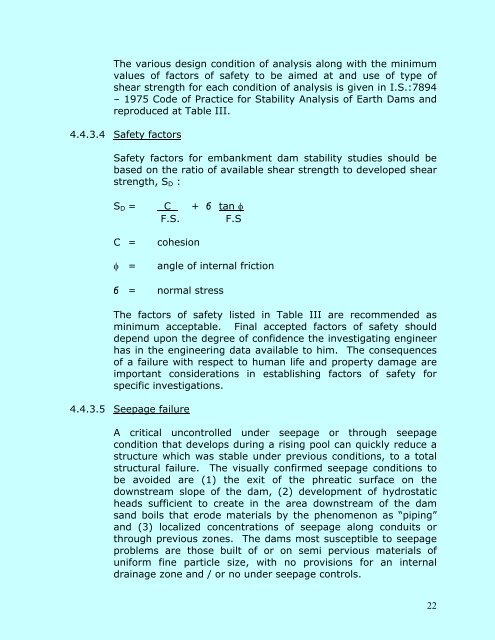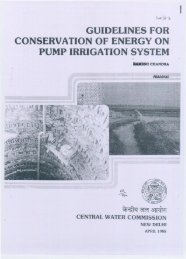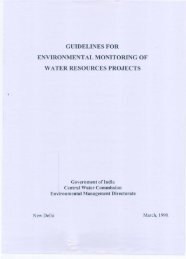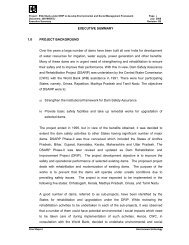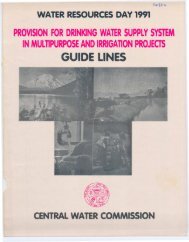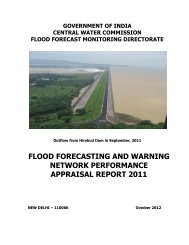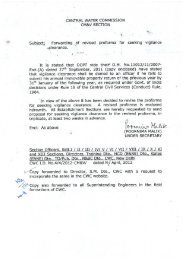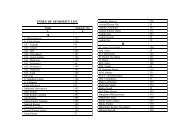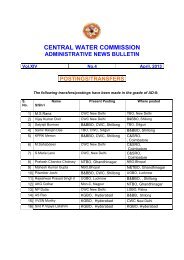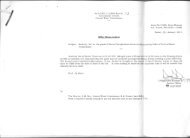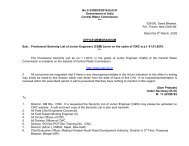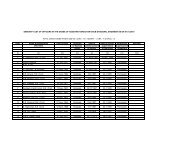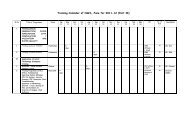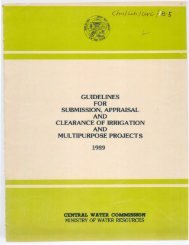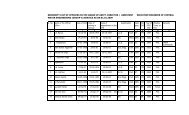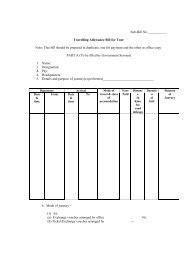Guidelines for Safety Inspection of Dams - Central Water Commission
Guidelines for Safety Inspection of Dams - Central Water Commission
Guidelines for Safety Inspection of Dams - Central Water Commission
Create successful ePaper yourself
Turn your PDF publications into a flip-book with our unique Google optimized e-Paper software.
The various design condition <strong>of</strong> analysis along with the minimum<br />
values <strong>of</strong> factors <strong>of</strong> safety to be aimed at and use <strong>of</strong> type <strong>of</strong><br />
shear strength <strong>for</strong> each condition <strong>of</strong> analysis is given in I.S.:7894<br />
– 1975 Code <strong>of</strong> Practice <strong>for</strong> Stability Analysis <strong>of</strong> Earth <strong>Dams</strong> and<br />
reproduced at Table III.<br />
4.4.3.4 <strong>Safety</strong> factors<br />
<strong>Safety</strong> factors <strong>for</strong> embankment dam stability studies should be<br />
based on the ratio <strong>of</strong> available shear strength to developed shear<br />
strength, SD :<br />
SD = C + б tan φ<br />
F.S. F.S<br />
C = cohesion<br />
φ = angle <strong>of</strong> internal friction<br />
б = normal stress<br />
The factors <strong>of</strong> safety listed in Table III are recommended as<br />
minimum acceptable. Final accepted factors <strong>of</strong> safety should<br />
depend upon the degree <strong>of</strong> confidence the investigating engineer<br />
has in the engineering data available to him. The consequences<br />
<strong>of</strong> a failure with respect to human life and property damage are<br />
important considerations in establishing factors <strong>of</strong> safety <strong>for</strong><br />
specific investigations.<br />
4.4.3.5 Seepage failure<br />
A critical uncontrolled under seepage or through seepage<br />
condition that develops during a rising pool can quickly reduce a<br />
structure which was stable under previous conditions, to a total<br />
structural failure. The visually confirmed seepage conditions to<br />
be avoided are (1) the exit <strong>of</strong> the phreatic surface on the<br />
downstream slope <strong>of</strong> the dam, (2) development <strong>of</strong> hydrostatic<br />
heads sufficient to create in the area downstream <strong>of</strong> the dam<br />
sand boils that erode materials by the phenomenon as “piping”<br />
and (3) localized concentrations <strong>of</strong> seepage along conduits or<br />
through previous zones. The dams most susceptible to seepage<br />
problems are those built <strong>of</strong> or on semi pervious materials <strong>of</strong><br />
uni<strong>for</strong>m fine particle size, with no provisions <strong>for</strong> an internal<br />
drainage zone and / or no under seepage controls.<br />
22


